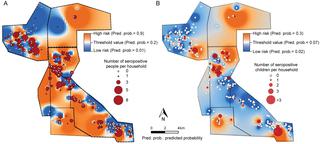当前位置:
X-MOL 学术
›
PLOS Negl. Trop. Dis.
›
论文详情
Our official English website, www.x-mol.net, welcomes your feedback! (Note: you will need to create a separate account there.)
Human Trypanosoma cruzi infection is driven by eco-social interactions in rural communities of the Argentine Chaco.
PLOS Neglected Tropical Diseases ( IF 3.8 ) Pub Date : 2019-12-16 , DOI: 10.1371/journal.pntd.0007430 Maria Del Pilar Fernández 1, 2, 3 , Maria Sol Gaspe 1, 2 , Paula Sartor 1, 4, 5 , Ricardo E Gürtler 1, 2
PLOS Neglected Tropical Diseases ( IF 3.8 ) Pub Date : 2019-12-16 , DOI: 10.1371/journal.pntd.0007430 Maria Del Pilar Fernández 1, 2, 3 , Maria Sol Gaspe 1, 2 , Paula Sartor 1, 4, 5 , Ricardo E Gürtler 1, 2
Affiliation

|
The transmission of Trypanosoma cruzi to humans is determined by multiple ecological, socio-economic and cultural factors acting at different scales. Their effects on human infection with T. cruzi have often been examined separately or using a limited set of ecological and socio-demographic variables. Herein, we integrated the ecological and social dimensions of human infection risk with the spatial distribution patterns of human and vector (Triatoma infestans) infection in rural communities of the Argentine Chaco composed of indigenous people (90% Qom) and a creole minority. We conducted serosurveys in 470 households aiming at complete population enumeration over 2012-2015. The estimated seroprevalence of T. cruzi prior to the implementation of an insecticide spraying campaign (2008) was 29.0% (N = 1,373 in 301 households), and was twice as large in Qom than creoles. Using generalized linear mixed models, human seropositive cases significantly increased with infected triatomine abundance, having a seropositive household co-inhabitant and household social vulnerability (a multidimensional index of poverty), and significantly decreased with increasing host availability in sleeping quarters (an index summarizing the number of domestic hosts for T. infestans). Vulnerable household residents were exposed to a higher risk of infection even at low infected-vector abundances. The risk of being seropositive increased significantly with house infestation among children from stable households, whereas both variables were not significantly associated among children from households exhibiting high mobility within the communities, possibly owing to less consistent exposures. Human infection was clustered by household and at a larger spatial scale, with hotspots of human and vector infection matching areas of higher social vulnerability. These results were integrated in a risk map that shows high-priority areas for targeted interventions oriented to suppress house (re)infestations, detect and treat infected children, and thus reduce the burden of future disease.
中文翻译:

阿根廷Chaco农村社区中的生态社会互动推动了人类克氏锥虫感染。
克氏锥虫向人类的传播是由多种不同规模的生态,社会经济和文化因素决定的。它们对人类感染克氏锥虫的影响经常被单独检查或使用一组有限的生态和社会人口统计学变量进行研究。在这里,我们将人类感染风险的生态和社会维度与由阿根廷人组成的阿根廷查科乡村社区(90%的库姆族裔)和克里奥尔族裔的人类和媒介(Triatoma infestans)感染的空间分布模式进行了整合。我们对470户家庭进行了血清调查,旨在对2012-2015年间的人口进行全面计数。在实施杀虫剂喷洒运动之前(2008年),估计的克鲁维螺旋体血清阳性率为29.0%(301户中N = 1,373),并且在库姆(Qom)的面积是克里奥尔人的两倍。使用广义线性混合模型,人类血清反应阳性病例随着三atomine的感染而显着增加,具有血清反应阳性家庭同居和家庭社会脆弱性(贫困的多维指标),并且随着睡眠区宿主数量的增加而显着下降(该指标概括了T. infestans的国内寄主数量)。弱势的家庭居民即使在低的感染媒介数量下也面临较高的感染风险。在稳定家庭的儿童中,随着房屋的侵扰,血清阳性的风险显着增加,而在社区内流动性高的家庭的儿童中,这两个变量之间的相关性并不显着,这可能是由于持续暴露的次数较少。人类感染是按家庭聚集的,并且分布在较大的空间范围内,而人类和媒介感染的热点与社会脆弱性较高的地区相匹配。这些结果已整合到一个风险图中,该图中显示了针对重点干预措施的高优先领域,这些干预措施旨在抑制家庭(再)感染,检测和治疗感染的儿童,从而减轻未来疾病的负担。
更新日期:2019-12-17
中文翻译:

阿根廷Chaco农村社区中的生态社会互动推动了人类克氏锥虫感染。
克氏锥虫向人类的传播是由多种不同规模的生态,社会经济和文化因素决定的。它们对人类感染克氏锥虫的影响经常被单独检查或使用一组有限的生态和社会人口统计学变量进行研究。在这里,我们将人类感染风险的生态和社会维度与由阿根廷人组成的阿根廷查科乡村社区(90%的库姆族裔)和克里奥尔族裔的人类和媒介(Triatoma infestans)感染的空间分布模式进行了整合。我们对470户家庭进行了血清调查,旨在对2012-2015年间的人口进行全面计数。在实施杀虫剂喷洒运动之前(2008年),估计的克鲁维螺旋体血清阳性率为29.0%(301户中N = 1,373),并且在库姆(Qom)的面积是克里奥尔人的两倍。使用广义线性混合模型,人类血清反应阳性病例随着三atomine的感染而显着增加,具有血清反应阳性家庭同居和家庭社会脆弱性(贫困的多维指标),并且随着睡眠区宿主数量的增加而显着下降(该指标概括了T. infestans的国内寄主数量)。弱势的家庭居民即使在低的感染媒介数量下也面临较高的感染风险。在稳定家庭的儿童中,随着房屋的侵扰,血清阳性的风险显着增加,而在社区内流动性高的家庭的儿童中,这两个变量之间的相关性并不显着,这可能是由于持续暴露的次数较少。人类感染是按家庭聚集的,并且分布在较大的空间范围内,而人类和媒介感染的热点与社会脆弱性较高的地区相匹配。这些结果已整合到一个风险图中,该图中显示了针对重点干预措施的高优先领域,这些干预措施旨在抑制家庭(再)感染,检测和治疗感染的儿童,从而减轻未来疾病的负担。



























 京公网安备 11010802027423号
京公网安备 11010802027423号